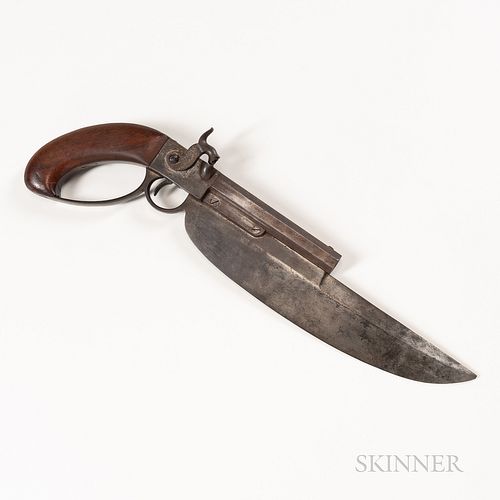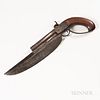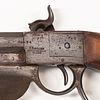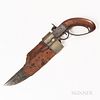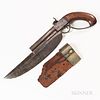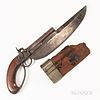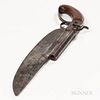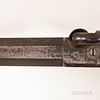Rare Cyrus B. Allen Elgin Patent Cutlass Pistol with Original Holster/Scabbard
Lot 187
About Seller
Bonhams Skinner
274 Cedar Hill Street
Marlborough, MA 01752
United States
Founded over four decades ago, Bonhams Skinner offers more than 60 auctions annually. Bonhams Skinner auctions reach an international audience and showcase the unique, rare, and beautiful in dozens of categories, including the fine and decorative arts, jewelry, modern design, musical instruments, sc...Read more
Categories
Estimate:
$15,000 - $25,000
Absentee vs Live bid
Two ways to bid:
- Leave a max absentee bid and the platform will bid on your behalf up to your maximum bid during the live auction.
- Bid live during the auction and your bids will be submitted real-time to the auctioneer.
Bid Increments
| Price | Bid Increment |
|---|---|
| $0 | $10 |
| $100 | $25 |
| $500 | $50 |
| $1,000 | $100 |
| $3,000 | $250 |
| $5,000 | $500 |
| $10,000 | $1,000 |
| $30,000 | $2,500 |
| $50,000 | $5,000 |
| $100,000 | $10,000 |
| $300,000 | $25,000 |
| $500,000 | $50,000 |
| $1,000,000 | $100,000 |
About Auction
By Bonhams Skinner
Oct 29, 2021
Set Reminder
2021-10-29 10:00:00
2021-10-29 10:00:00
America/New_York
Bidsquare
Bidsquare : Historic Arms & Militaria
https://www.bidsquare.com/auctions/skinner/historic-arms-militaria-7693
The William Rose collection features nearly 180 lots of rare and important 17th & 18thc. muskets, bayonets, pistols, swords, powder horns, accoutrements and documents used by British, French, and American forces who served in America's colonial wars and American Revolution. Bonhams Skinner bidsquare@bonhamsskinner.com
The William Rose collection features nearly 180 lots of rare and important 17th & 18thc. muskets, bayonets, pistols, swords, powder horns, accoutrements and documents used by British, French, and American forces who served in America's colonial wars and American Revolution. Bonhams Skinner bidsquare@bonhamsskinner.com
- Lot Description
Rare Cyrus B. Allen Elgin Patent Cutlass Pistol with Original Holster/Scabbard, Springfield, Massachusetts, 1837, serial number 34, 5 in., .54 caliber octagonal barrel with narrow brass sight, long Bowie knife-style blade and integral trigger guard mounted below, the lock with plain hammer, arched walnut grip, the top of the barrel stamped "ELGINS/PATENT" and "CBA/PM/1837" at the breech, the left side of the frame marked "C.B. ALLEN/SPRINGFIELD/MASS.," serial numbers located on the left side of the barrel at the breech, on the frame, on the left side of the blade at the rear, on the two barrel retaining screws, and on the upper surface of the side plate beneath the top plate; surviving with the pistol is the original holster/scabbard retaining the German silver throat and most of the leather body, blade lg. 11 1/2, overall lg. 17 in.
Note: The inventor of this unique weapon, New Yorker George Elgin, took advantage of the popularity of the famous ôBowieö knife, envisioning a new style combination firearm and edged weapon that would prove effective in close combat. On July 5th, 1837, Elgin was granted United States Patent No. 254 for his ôImprovement in the Pistol Knife or Cutlass.ö On September 8th, 1837, he wrote to the United States Navy Department proposing to deliver by October 25th 150 ôPistol Knivesö for use in a planned expedition to explore the South Seas. The Navy accepted ElginÆs proposal and with it was born the United States militaryÆs first official percussion handgun. Cyrus B. Allen produced 150 of these pistols for the U.S. Navy. The Bowie knife-style blades were produced by Nathaniel P. Ames.
The cost of the Elgin Patent Cutlass Pistol made by Allen was $17.50. Each was delivered with a German silver-mounted leather holster/scabbard that incorporated a brass-tipped rammer, cleaning equipment, three spare percussion cap nipples, and a storage box.
The United States Exploring Expedition to the South Seas spanned the years 1838-1842. The expedition was composed of five U.S. Navy ships and 350 men, including sailors, naturalists, botanists, a mineralogist, a taxidermist, and a philologist. During the four years of the voyage the expedition surveyed over 200 South Pacific islands and made the first sightings of Antarctica. Scientists on the expedition collected over 60,000 plant and bird specimens; many of which served as the basis for the Smithsonian InstitutionÆs earliest natural history collections.
The expedition occasionally found itself in conflict with Native peoples and the published narrative of the expedition documents that the cutlass pistol saw use during the voyage. On the Island of Malolo in Fiji on July 24th, 1840, members of a landing party were attacked by Natives and Midshipman Wilkes Henry pursued an islander and ôcut him down with his bowie-knife pistol.ö In another instance when the expedition was exploring the Sacramento River, an Indian ôboldly seized the bowie-knife-pistol of Dr. Pickering,ö a naturalist, and ran into the woods.
Upon the expeditionÆs return to the United States in 1842 the pistols went into Navy stores. Five years later it is possible that some of these pistols went on the U.S. NavyÆs Dead Sea Expedition of 1847 as included in the list of armaments taken on the expedition are fourteen pistols including ôfour revolving and ten with bowie-knife blades attached.ö Sources suggest that some Elgin Patent Cutlass Pistols remained in the U.S. Navy inventory until the 1860s and that some may have been used during the Civil War.Condition
Condition: Metal varies from a mottled gray to gray/brown with only tiny scattered spots of surface oxidation with virtually no underlying pitting, there is surface oxidation on and around the nipple and adjacent area of the frame, action is smooth, mainspring is strong, forward edge of cock where it surrounds the nipple has a loss, tip of blade has a tiny loss, grip has scattered minor dings and dents and an old reglued chip at the base where the grip joins the knuckle bow on the right side; holster/scabbard metal has thin oxidation and a few minor scratches, leather surface is degraded and stitching is missing, but leather remains securely attached to the mount, tip is missing as is the cleaning rod.
Any condition statement is given as a courtesy to a client, is only an opinion and should not be treated as a statement of fact. Skinner Inc. shall have no responsibility for any error or omission. The absence of a condition statement does not imply that the lot is in perfect condition or completely free from wear and tear, imperfections or the effects of aging. - Shipping Info
-
Please visit http://www.skinnerinc.com/services/payment-and-shipping/ for information regarding the collection of items purchased at auction.
-
- Buyer's Premium



 EUR
EUR CAD
CAD AUD
AUD GBP
GBP MXN
MXN HKD
HKD CNY
CNY MYR
MYR SEK
SEK SGD
SGD CHF
CHF THB
THB